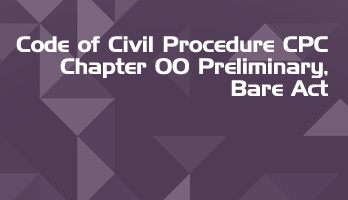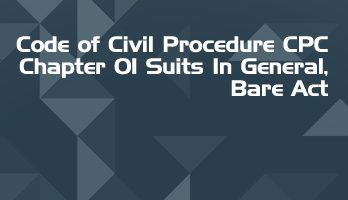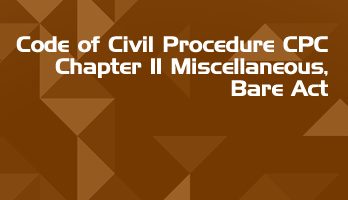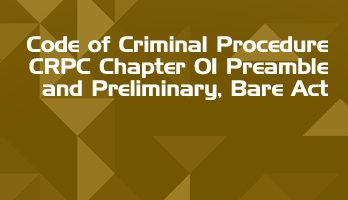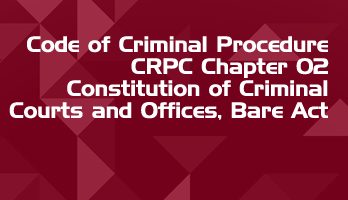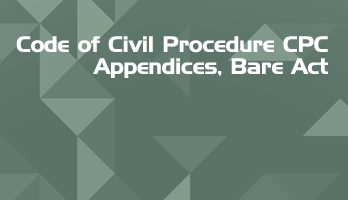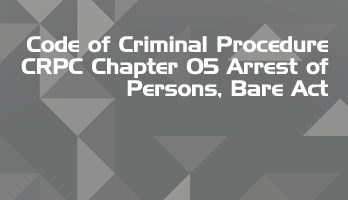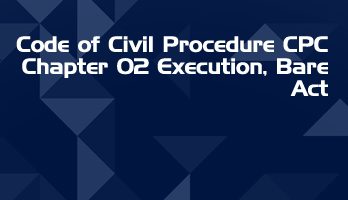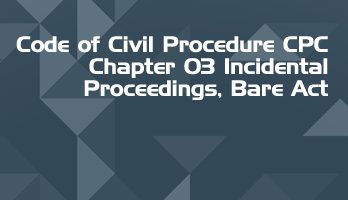A 'Bare act' is the actual legislation passed by the Parliament of India. Generally, an act sets out the high level legal and policy principles applicable to the subject matter of the law.
Most acts are accompanied by 'subsidiary legislation' such as rules, regulations, notifications and orders; which address the actual implementation detail of the act.
Free Full Course Available on LawMint's YouTube Channel
How to Land Your Dream LLB Internship in a Top Law Firm
- Part 1 - Introduction
- Part 2 - Internship Planning
- Part 3 - Internship Research
- Part 4 - Building Your Profile
- Part 5 - The Email
- Part 6 - The Resume
- Part 7 - The Cover Letter
- Part 8 - The Interview
- Part 9 - Self Development
Practical and comprehensive course, with real examples and step-by-step analysis of the complete internship application process. Check out LawMint's YouTube channel now!
Indian Penal Code, 1860
Chapter XVIII – Of Offences Relating to Documents and to Property Marks
Section 463 – Forgery
Whoever makes any false document or false electronic record or part of a document with intent to cause damage or injury, to the public or to any person, or to support any claim or title, or to cause any person to part with property, or to enter into any express or implied contract, or with intent to commit fraud or that fraud may be committed, commits forgery.
Section 464 – Making a false document
A person is said to make a false document or false electronic record:
First – Who dishonestly or fraudulently –
- makes, sign, seals or executes a document or part of a document;
- makes or transmits any electronic record or part of any electronic record;
- affixes any digital signature on any electronic record;
- makes any mark denoting the execution of a document or the authenticity of the digital signature, with the intention of causing it to be believed that such document or part of document, electronic record or digital signature was made, signed, sealed, executed, transmitted or affixed by or by the authority or a person by whom or by whose authority he knows that it was not made, signed, sealed, executed or affixed; or
Secondly – who, without lawful authority, dishonestly or fraudulently, by cancellation or otherwise, alters a document or an electronic record in any material part thereof, after it has been made, executed or affixed with digital signature either by himself or by any other person, whether such person be living or dead at the time of such alteration; or
Thirdly – who dishonestly or fraudulently causes any person, sign, seal, execute or alter a document or an electronic record or to affix his digital signature on any electronic record knowing that such person by reason of unsoundness of mind or intoxication cannot, or that by reason of deception practiced upon him, he does not know the contents of the document or electronic record or the nature of the alteration.
Illustrations
- A has a letter of credit upon B for rupees 10,000, written by Z. A, in order to defraud B, adds cipher to the 10,000, and makes the sum 1,00,000 intending that it may be believed by B that Z so wrote the letter. A has committed forgery.
- A without Z – authority, affixes Z – seal to a document purporting to be a conveyance of an estate from Z to A, with the intention of selling the estate to B and thereby of obtaining from B the purchase – money. A has committed forgery.
- A picks up a cheque on a banker signed by B, payable to bearer, but without any sum having been inserted in the cheque. A fraudulently fills up the cheque by inserting the sum of ten thousand rupees. A commits forgery.
- A leaves with B, his agent, a cheque on a banker, signed by A, without inserting the sum payable and authorizes B to fill up the cheque by inserting a sum not exceeding ten thousand rupees for the purpose of making certain payments. B fraudulently fills up the cheque by inserting the sum of twenty thousand rupees. B commits forgery.
- A draws a bill of exchange on himself in the name of B without B – authority, intending to discount it as a genuine bill with a banker and intending to take up the bill on its maturity. Here, as A draws the bill with intent to deceive the banker by leading him to suppose that he had the security of B, and thereby to discount the bill, A is guilty of forgery.
- Z – will contains these words – I direct that all my remaining property be equally divided between A, B and C. – A dishonestly scratches out B – name, intending that it may be believed that the whole was left to himself and C. A has committed forgery.
- A endorses a Government promissory note and makes it payable to Z for his order by writing on the bill the words – Pay to Z or his order – and signing the endorsement. B dishonestly erases the words – Pay to Z or his order -, and thereby converts the special endorsement into a blank endorsement. B commits forgery.
- A sells and conveys an estate to Z. A afterwards, in order to defraud Z of his estate, executes a conveyance of the same estate to B, dated six months earlier than the date of the conveyance to Z, intending it to be believed that he had conveyed the estate to B before he conveyed it to Z. A has committed forgery.
- Z dictates his will to A. A intentionally writes down a different legatee named by Z, and by representing to Z that he has prepared the will according to his instructions, induces Z to sign the will. A has committed forgery.
- A writes a letter and signs it with B – name without B – authority, certifying that A is a man of good character and in distressed circumstances from unforeseen misfortune, intending by means of such letter to obtain alms from Z and other persons. Here, as A made a false document in order to induce Z to part with property, A has committed forgery.
- A without B – authority writes a letter and signs it in B – name certifying to A – character, intending thereby to obtain employment under Z. A has committed forgery inasmuch as he intended to deceive Z by the forged certificate, and thereby to induce Z to enter into an express or implied contract for service.
Explanations
- A man – s signature of his own name may amount to forgery.
Illustrations
- A signs his own name to a bill of exchange, intending that it may be believed that the bill was drawn by another person of the same name. A has committed forgery.
- A writes the word – accepted – on a piece of paper and signs it with Z – name, in order that B may afterwards write on the paper a bill of exchange drawn by B upon Z, and negotiate the bills as though it had been accepted by Z. A is guilty of forgery; and if B, knowing the fact, draws the bill upon the paper pursuant to A – intention, B is also guilty of forgery.
- A picks up a bill of exchange payable to the order of a different person of the same name. A endorses the bill in his own name, intending to cause it to be believed that it was endorsed by the person to whose order it was payable; here A has committed forgery.
- A purchases an estate sold under execution of a decree against B. B, after the seizure of the estate, in collusion with Z, executes a lease of the estate to Z at a nominal rent and for a long period and dates the lease six months prior to the seizure, with intent to defraud A, and to cause it to be believed that the lease was granted before the seizure. B, though he executes the lease in his own name, commits forgery by antedating it.
- A, a trader, in anticipation of insolvency, lodges effects with B for A – benefit, and with intent to defraud his creditors; and in order to give a colour to the transaction, writes a promissory note binding himself to pay to B a sum for value received, and antedates the note, intending that it may be believed to have been made before A was on the point of insolvency. A has committed forgery under the first head of the definition.
Explanations
- The making of a false document in the name of a fictious person, intending it to be believed that the document was made by real person, or in the name of a deceased person, intending it to be believed that the document was made by the person in his lifetime, may amount to forgery.
Illustrations
- A draws a bill of exchange upon a fictious person, and fraudulently accepts the bill in the name of such fictitious person with intent to negotiate it. A commits forgery.
Explanations
- For the purposes of this section, the expression – affixing digital signature – shall have the meaning assigned to it in clause (d) of sub – section (1) of section 2 of the Information Technology Act, 2000.
Section 465 – Punishment for forgery
Whoever commits forgery shall be punished with imprisonment of either description for a term which may extend to two years, or with fine, or with both.
Section 466 – Forgery of record of Court or of public register, etc.
Whoever forges a document or electronic record, purporting to be a record or proceeding of or in a Court of Justice, or a register of birth, baptism, marriage or burial, or a register kept by a public servant as such, or a certificate or document or electronic record purporting to be made by a public servant in his official capacity, or an authority to institute or defend a suit, or to take any proceedings therein, or to confess judgment, or a power of attorney, shall be punished with imprisonment of either description for a term which may extend to seven years, and shall also be liable to fine.
Section 467 – Forgery of valuable security, will, etc.
Whoever forges a document or electronic record which purports to be a valuable security or a will, or an authority to adopt a son, or which purports to give authority to any person to make or transfer any valuable security, or to receive the principal, interest or dividends thereon, or to receive or deliver any money, movable property, or valuable security, or any document or electronic record purporting to be an acquittance or receipt acknowledging the payment of money, or an acquittance or receipt for the delivery of any movable property or valuable security, shall be punished with 1 *imprisonment for life, or with imprisonment of either description for a term which may extend to ten years, and shall also be liable to fine.
Section 468 – Forgery for purpose of cheating
Whoever commits forgery, intending that the document or electronic record forged shall be used for the purpose of cheating, shall be punished with imprisonment of either description for a term which may extend to seven years, and shall also be liable to fine.
Section 469 – Forgery for purpose of harming reputation
Whoever commits forgery, intending that the document or electronic record forged shall harm the reputation of any party, or knowing that it is likely to be used for that purpose, shall be punished with imprisonment of either description for a term which may extend to three years, and shall also be liable to fine.
Section 470 – Forged document
A false document or electronic record made wholly or in part by forgery is designated – a forged document or electronic record – .
Section 471 – Using as genuine a forged document
Whoever fraudulently or dishonestly uses as genuine any document or electronic record which he knows or has reason to believe to be a forged document or electronic record, shall be punished in the same manner as if he had forged such document or electronic record.
Section 472 – Making or possessing counterfeit seal, etc., with intent to commit forgery punishable under section 467
Whoever makes or counterfeits any seal, plate or other instrument for making an impression, intending that the same shall be used for the purpose of committing any forgery which would be punishable under section 467 of this Code, or, with such intent, has in his possession any such seal, plate or other instrument, knowing the same to be counterfeit, shall be punishable with imprisonment for life, or with imprisonment of either description for a term which may extend to seven years, and shall also be liable to fine.
Section 473 – Making or possessing counterfeit seal, etc., with intent to commit forgery punishable otherwise
Whoever makes or counterfeits any seal, plate or other instrument for making an impression, intending that the same shall be used for the purpose of committing any forgery which would be punishable under any section of this Chapter other than section 467, or, with such intent, has in his possession any such seal, plate or other instrument, knowing the same to be counterfeit, shall be punished with imprisonment of either description for a term which may extend to seven years, and shall also be liable to fine.
Section 474 – Having possession of document described in section 466 or 467, knowing it to be forged and intending to use it genuine
Whoever has in his possession any document or electronic record, knowing the same to be forged, and intending that the same shall fraudulently or dishonestly be used as genuine, shall, if the document or electronic record is one of the description mentioned in section 466 of this Code, be punished with imprisonment of either description for a term which may extend to seven years, and shall also be liable to fine; and if the document or electronic record is one of the description mentioned in section 467, shall be punished with imprisonment for life, or with imprisonment of either description, for a term which may extend to seven years, and shall also be liable to fine.
Section 475 – Counterfeiting device or mark used for authenticating documents described in section 467, or possessing counterfeit marked material
Whoever counterfeits upon, or in the substance of, any material, any device or mark used for the purpose of authenticating any document described in section 467 of this Code, intending that such device or mark shall be used for the purpose of giving the appearance of authenticity to any document then forged or thereafter to be forged on such material, or who, with such intent, has in his possession any material upon or in the substance of which any such device or mark has been counterfeited, shall be punished with 1 *imprisonment for life, or with imprisonment of either description for a term which may extend to seven years, and shall also be liable to fine.
Section 476 – Counterfeiting device or mark used for authenticating documents other than those described in section 467, or possessing counterfeit marked material
Whoever counterfeits upon, or in the substance of, any material, any device or mark used for the purpose of authenticating any document or electronic record other than the documents described in section 467 of this Code, intending that such device or mark shall be used for the purpose of giving the appearance of authenticity to any document or electronic record then forged or thereafter to be forged on such material, or who with such intent, has in his possession any material upon or in the substance of which any such device or mark has been counterfeited, shall be punished with imprisonment of either description for a term which may extend to seven years, and shall also be liable to fine.
Whoever fraudulently or dishonestly, or with intent to cause damage or injury to the public or to any person, cancels, destroys or defaces, or attempts to cancel, destroy or deface, or secretes or attempts to secrete any document which is or purports to be a will, or an authority to adopt a son, or any valuable security, or commits mischief in respect of such document, shall be punished with imprisonment for life, or with imprisonment of either description for a term which may extend to seven years, and shall also be liable to fine.
Section 477A – Falsification of accounts
Whoever, being a clerk, officer or servant, or employed or acting in the capacity of a clerk, officer or servant, wilfully, and with intent to defraud, destroys, alters, mutilates or falsifies any book, electronic record, paper, writing, valuable security or account which belongs to or is in the possession of his employer, or has been received by him for or on behalf of his employer, or wilfully, and with intent to defraud, makes or abets the making of any false entry in, or omits or alters or abets the omission or alteration of any material particular from or in. any such book, electronic record, paper, writing, valuable security or account, shall be punished with imprisonment of either description for a term which may extend to seven years, or with fine, or with both.
Explanations
- It shall be sufficient in any charge under this section to allege a general intent to defraud without naming any particular person intended to be defrauded or specifying any particular sum of money intended to be the subject of the fraud, or any particular day on which the offence was committed.
Section 478 – (Repealed) Trade Mark.
Rep. by the Trade and Merchandise Marks Act, 1958 (43 of 1958)
Section 479 – Property mark
A mark used for denoting that movable property belongs to a particular person is called a property mark.
Section 480 – (Repealed) Using a false trade mark.
Rep. by the Trade and Merchandise Marks Act, 1958 (43 of 1958)
Section 481 – Using a false property mark
Whoever marks any movable property or goods or any case, package or other receptacle containing movable property or goods, or uses any case, package or other receptacle having any mark thereon, in a manner reasonably calculated to cause it to be believed that the property or goods so marked, or any property or goods contained in any such receptacle so marked, belong to a person to whom they do not belong, is said to use a false property mark.
Section 482 – Punishment for using a false property mark
Whoever uses any false property mark shall, unless he proves that he acted without intent to defraud, be punished with imprisonment of either description for a term which may extend to one year, or with fine, or with both.
Section 483 – Counterfeiting a property mark used by another
Whoever counterfeits any property mark used by any other person shall be punished with imprisonment of either description for a term which may extend to two years, or with fine, or with both.
Section 484 – Counterfeiting a mark used by a public servant
Whoever counterfeits any property mark used by a public servant, or any mark used by a public servant to denote that any property has been manufactured by a particular person or at a particular time or place, or that the property is of a particular quality or has passed through a particular office, or that it is entitled to any exemption, or uses as genuine any such mark knowing the same to be counterfeit, shall be punished with imprisonment of either description for a term which may extend to three years, and shall also be liable to fine.
Section 485 – Making or possession of any instrument for counterfeiting a property mark
Whoever makes or has in his possession any die, plate or other instrument for the purpose of counterfeiting a proper mark, or has in his possession a property mark for the purpose of denoting that any goods belong to a person to whom they do not belong, shall be punished with imprisonment of either description for a term which may extend to three years, or with fine, or with both.
Section 486 – Selling goods marked with a counterfeit property mark
Whoever sells, or exposes, or has in possession for sale, any goods or things with a counterfeit property mark affixed to or impressed upon the same or to or upon any case, package or other receptacle in which such goods are contained, shall, unless he proves:
- that, having taken all reasonable precautions against committing an offence against this section, he had at the time of the commission of the alleged offence no reason to suspect the genuineness of the mark, and
- that, on demand made by or on behalf of the prosecutor, he gave all the information in his power with respect to the persons from whom he obtained such goods or things, or
- that otherwise he had acted innocently, be punished with imprisonment of either description for a term which may extend to one year, or with fine, or with both.
Section 487 – Making a false mark upon any receptacle containing goods
Whoever makes any false mark upon any case, package or other receptacle containing goods, in a manner reasonably calculated to cause any public servant or any other person to believe that such receptacle contains goods which it does not contain or that it does not contain goods which it does contain, or that the goods contained in such receptacle are of a nature or quality different from the real nature or quality thereof, shall, unless he proves that he acted without intent to defraud, be punished with imprisonment of either description for a term which may extend to three years, or with fine, or with both.
Section 488 – Punishment for making use of any such false mark
Whoever makes use of any such false mark in any manner prohibited by the last foregoing section shall, unless he proves that he acted without intent to defraud, be punished as if he had committed an offence against that section.
Section 489 – Tampering with property mark with intent to cause injury
Whoever removes, destroys, defaces or adds to any property mark, intending or knowing it to be likely that he may thereby cause injury to any person, shall be punished with imprisonment of either description for a term which may extend to one year, or with fine, or with both.
Section 498A – Counterfeiting currency – notes or bank – notes
Whoever counterfeits, or knowingly performs any part of the process of counterfeiting, any currency – note or bank – note, shall be punished with imprisonment for life, or with imprisonment of either description for a term which may extend to ten years, and shall also be liable to fine.
Explanations
- For the purposes of this section and of sections 489B, 489C, 489D and 489E, the expression – bank – note – means a promissory note or engagement for the payment of money to bearer on demand issued by any person carrying on the business of banking in any part of the world, or issued by or under the authority of any State or Sovereign Power, and intended to be used as equivalent to, or as a substitute for money.
Section 489B – Using as genuine, forged or counterfeit currency – notes or bank – notes
Whoever sells to, or buys or receives from, any other person, or otherwise traffics in or uses as genuine, any forged or counterfeit currency – note or bank – note, knowing or having reason to believe the same to be forged or counterfeit, shall be punished with 2 *imprisonment for life, or with imprisonment of either description for a term which may extend to ten years, and shall also be liable to fine.
Section 489C – Possession of forged or counterfeit currency – notes or bank – notes
Whoever has in his possession any forged or counterfeit currency – note or bank – note, knowing or having reason to believe the same to be forged or counterfeit and intending to use the same as genuine or that it may be used as genuine, shall be punished with imprisonment of either description for a term which may extend to seven years, or with fine, or with both.
Section 489D – Making or possessing instruments or materials for forging or counterfeiting currency notes or bank – notes
Whoever makes, or performs any part of the process of making, or buys of sells or disposes of, or has in his possession, any machinery, instrument of material for the purpose of being used, or knowing or having reason to believe that it is intended to be used, for forging or counterfeiting any currency – note or bank – note, shall be punished with 1 *imprisonment for life, or with imprisonment of either description for a term which may extend to ten years, and shall also be liable to fine.
Section 489E – Making or using documents resembling currency – notes or bank – notes
- Whoever makes, or causes to be made, or uses for any purpose whatsoever, or delivers to any person, any document purporting to be, or in any way resembling, or so nearly resembling as to be calculated to deceive, any currency – note or bank – note shall be punished with fine which may extend to one hundred rupees.
- If any person, whose name appears on a document the making of which is an offence under sub – section (1), refuses, without lawful excuse, to disclose to a police – officer on being so required the name and address of the person by whom it was printed or otherwise made, he shall be punished with fine which may extend to two hundred rupees.
- Where the name of any person appears on any document in respect of which any person is charged with an offence under sub – section (1) or on any other document used or distributed in connection with that document it may, until the contrary is proved, be presumed that that person caused the document to be made.
Important Central Acts in Regional Languages
Legislative department website also features regional language versions of several important Central Acts.
Free Full Course Available on LawMint's YouTube Channel
How to Land Your Dream LLB Internship in a Top Law Firm
- Part 1 - Introduction
- Part 2 - Internship Planning
- Part 3 - Internship Research
- Part 4 - Building Your Profile
- Part 5 - The Email
- Part 6 - The Resume
- Part 7 - The Cover Letter
- Part 8 - The Interview
- Part 9 - Self Development
Practical and comprehensive course, with real examples and step-by-step analysis of the complete internship application process. Check out LawMint's YouTube channel now!



